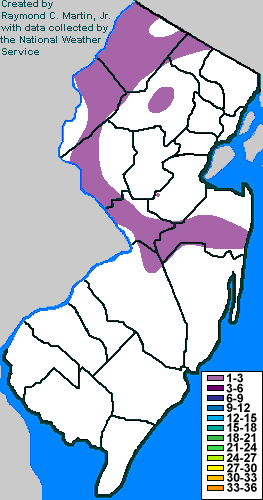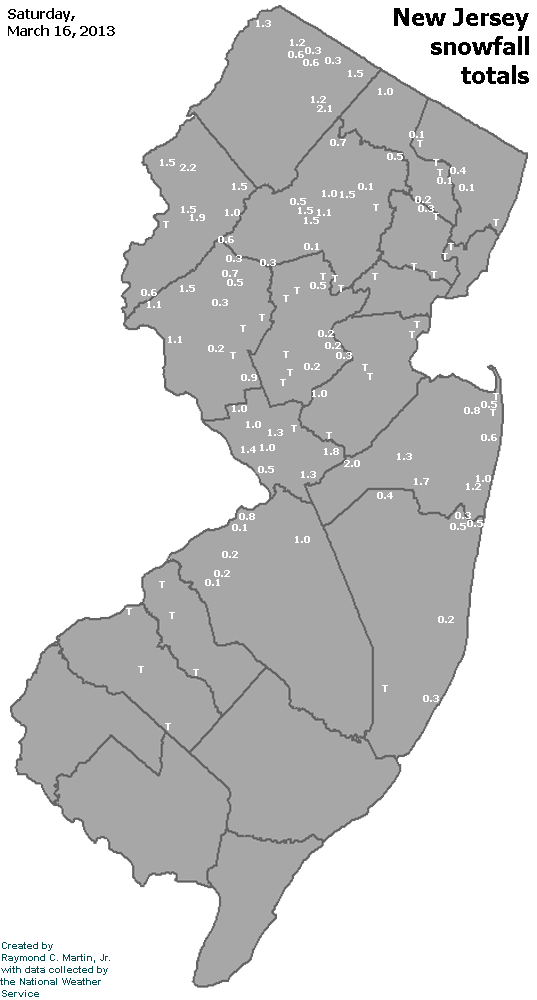

Storm description, surface observations, snowfall totals, and images courtesy of the National Climatic Data Center, the National Centers of Environmental Prediction, the Climate Prediction Center, the Hydrometeorological Prediction Center, the Mount Holly National Weather Service Office, the Upton National Weather Service Office, Rutgers University, Plymouth State University, the University of Illinois, the American Meteorological Society, Weather Graphics Technologies, AccuWeather, and the Weather Channel.
Table of Contents
Storm Summary
Regional Surface Observations
National Weather Service Forecasts
Surface Maps
Satellite Imagery
National Surface Weather Maps - Pressure and Fronts Only
Continental Surface Weather Maps - Pressure and Fronts Only
Sea Level Pressure and 1000 to 500 Millibar Thickness Maps
850 Millibar Maps
700 Millibar Maps
500 Millibar Maps
300 Millibar Maps
200 Millibar Maps
National Radar Imagery
Regional Radar Imagery
Fort Dix Doppler Radar Imagery

Contoured Snowfall Totals from March 16, 2013
STORM DESCRIPTION
A wave of low pressure brought another round of snow and sleet to parts of New Jersey.
Synoptic Discussion
A cold front entered the northern Plains of the United States from Canada on the 14th, accompanied by a wave of low pressure further west which entered Montana. By midday on the 15th, the cold front stretched across the Great Lakes while the wave of low pressure was over Iowa. The cold front crossed New Jersey late on the 15th and early on the 16th while the wave of low pressure moved into Illinois. By midday on the 16th, the wave of low pressure started to cross West Virginia, while by evening it had exited the coast into the Atlantic near the Maryland and Virginia border. By the early morning hours of the 17th, it was well out to sea.
Local Discussion
Precipitation overspread New Jersey from west to east during the morning hours of the 16th. In southern New Jersey, temperatures were warm enough such that mainly rain and sleet fell, but in central New Jersey sleet and snow occurred, while in northern New Jersey mainly snow fell. Additional bands of precipitation, some accompanied by thunder and lightning, moved east across the state during the afternoon. Precipitation exited the state from west to east during the early evening of the 16th. The heaviest precipitation fell over central and northwestern New Jersey, with significantly lesser amounts to the northeast and south. Snow totals ranged from a coating to 2 inches in Sussex, Warren, Morris, Hunterdon, Mercer and Monmouth counties, with an inch or less in Passaic, Bergen, Essex, Hudson, Union, Somerset, Middlesex, Burlington, Ocean, Gloucester and Camden counties. Little if any snow fell in Salem, Cumberland, Atlantic and Cape May counties.
New Jersey Snowfall Totals

Individual Snowfall Totals from March 16, 2013
Table of Contents
Storm Summary
Regional Surface Observations
National Weather Service Forecasts
Surface Maps
Satellite Imagery
National Surface Weather Maps - Pressure and Fronts Only
Continental Surface Weather Maps - Pressure and Fronts Only
Sea Level Pressure and 1000 to 500 Millibar Thickness Maps
850 Millibar Maps
700 Millibar Maps
500 Millibar Maps
300 Millibar Maps
200 Millibar Maps
National Radar Imagery
Regional Radar Imagery
Fort Dix Doppler Radar Imagery
Snow storm, November 7-8, 2012
Snow and ice storm, December 29, 2012
Snow storm, January 25, 2013
Snow and ice storm, February 8-9, 2013
Snow storm, March 7-8, 2013
Snow storm, March 16, 2013
Back to Ray's Winter Storm Archive
Copyright © 2014 by Raymond C Martin Jr. All rights reserved